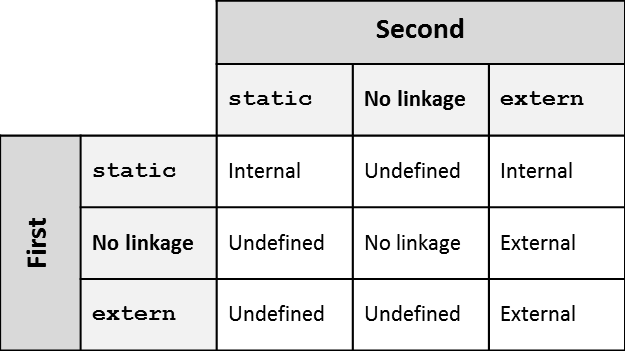
Linkage can make an identifier declared in different scopes or declared multiple times within the same scope refer to the same object or function. Identifiers are classified as externally linked, internally linked, or not linked. These three kinds of linkage have the following characteristics [Kirch-Prinz 2002]:
According to the C Standard, 6.2.2 [ISO/IEC 9899:2011], linkage is determined as follows:
If the declaration of a file scope identifier for an object or a function contains the storage class specifier
static, the identifier has internal linkage.For an identifier declared with the storage-class specifier
externin a scope in which a prior declaration of that identifier is visible, if the prior declaration specifies internal or external linkage, the linkage of the identifier at the later declaration is the same as the linkage specified at the prior declaration. If no prior declaration is visible, or if the prior declaration specifies no linkage, then the identifier has external linkage.If the declaration of an identifier for a function has no storage-class specifier, its linkage is determined exactly as if it were declared with the storage-class specifier
extern. If the declaration of an identifier for an object has file scope and no storage-class specifier, its linkage is external.The following identifiers have no linkage: an identifier declared to be anything other than an object or a function; an identifier declared to be a function parameter; a block scope identifier for an object declared without the storage-class specifier
extern.
Use of an identifier (within one translation unit) classified as both internally and externally linked is undefined behavior. (See also undefined behavior 8.) A translation unit includes the source file together with its headers and all source files included via the preprocessing directive #include.
The following table identifies the linkage assigned to an object that is declared twice in a single translation unit. The column designates the first declaration, and the row designates the redeclaration.

In this noncompliant code example, i2 and i5 are defined as having both internal and external linkage. Future use of either identifier results in undefined behavior.
int i1 = 10; /* Definition, external linkage */
static int i2 = 20; /* Definition, internal linkage */
extern int i3 = 30; /* Definition, external linkage */
int i4; /* Tentative definition, external linkage */
static int i5; /* Tentative definition, internal linkage */
int i1; /* Valid tentative definition */
int i2; /* Undefined, linkage disagreement with previous */
int i3; /* Valid tentative definition */
int i4; /* Valid tentative definition */
int i5; /* Undefined, linkage disagreement with previous */
int main(void) {
/* ... */
return 0;
}
|
Microsoft Visual Studio 2013 issues no warnings about this code, even at the highest diagnostic levels.
GCC and Clang 14 both generate fatal diagnostics for the conflicting definitions of i2 and i5.
This compliant solution does not include conflicting definitions:
int i1 = 10; /* Definition, external linkage */
static int i2 = 20; /* Definition, internal linkage */
extern int i3 = 30; /* Definition, external linkage */
int i4; /* Tentative definition, external linkage */
static int i5; /* Tentative definition, internal linkage */
int main(void) {
/* ... */
return 0;
}
|
Use of an identifier classified as both internally and externally linked is undefined behavior.
Rule | Severity | Likelihood | Remediation Cost | Priority | Level |
|---|---|---|---|---|---|
DCL36-C | Medium | Probable | Medium | P8 | L2 |
Tool | Version | Checker | Description |
|---|---|---|---|
| Astrée | static-function-declaration static-object-declaration | Partially checked | |
| Axivion Bauhaus Suite | CertC-DCL36 | Fully implemented | |
| CodeSonar | LANG.STRUCT.DECL.NOEXT | Missing External Declaration | |
| Coverity | PW.LINKAGE_CONFLICT | Implemented | |
CC2.DCL36 | Fully implemented | ||
| GCC | |||
| Helix QAC | C0625 | Fully implemented | |
| Klocwork | MISRA.FUNC.STATIC.REDECL | Fully implemented | |
| LDRA tool suite | 461 S, 575 S, 2 X | Fully implemented | |
| PC-lint Plus | 401, 839, 1051 | Fully supported | |
| Splint | |||
| Parasoft C/C++test | CERT_C-DCL36-a | Identifiers shall not simultaneously have both internal and external linkage in the same translation unit | |
| Polyspace Bug Finder | Checks for inconsistent use of static and extern in object declarations (rule partially covered) | ||
| RuleChecker | static-function-declaration static-object-declaration | Partially checked | |
| TrustInSoft Analyzer | non-static declaration follows static declaration | Partially verified. |
Search for vulnerabilities resulting from the violation of this rule on the CERT website.
Key here (explains table format and definitions)
Taxonomy | Taxonomy item | Relationship |
|---|---|---|
| MISRA C:2012 | Rule 8.2 (required) | Prior to 2018-01-12: CERT: Unspecified Relationship |
| MISRA C:2012 | Rule 8.4 (required) | Prior to 2018-01-12: CERT: Unspecified Relationship |
| MISRA C:2012 | Rule 8.8 (required) | Prior to 2018-01-12: CERT: Unspecified Relationship |
| MISRA C:2012 | Rule 17.3 (mandatory) | Prior to 2018-01-12: CERT: Unspecified Relationship |
| [Banahan 2003] | Section 8.2, "Declarations, Definitions and Accessibility" |
| [ISO/IEC 9899:2011] | 6.2.2, "Linkages of Identifiers" |
| [Kirch-Prinz 2002] |